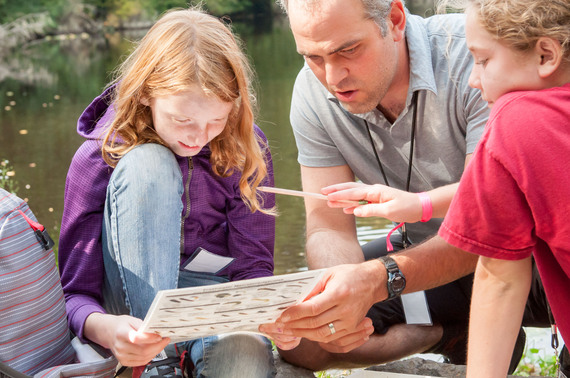As I entered my first year in the classroom, a veteran teacher offered me some advice: "Don't smile until December." This was her not-so-subtle hint at how to maintain order in school. And so I began teaching with a clear vision for my class: my students would sit still at their desks in uniform rows, fully focused as I taught at the blackboard. When they wished to speak, they'd politely raise their hands. Needless to say, it didn't take long for me to realize that my vision was outdated and deeply flawed, because my students' natural inclination was to move, discover, and play.
I now manage IslandWood, which is one of the nation's largest environmental education organizations. Each year, we serve 175 schools at multiple locations throughout the Pacific Northwest - getting tens of thousands of kids up and away from their chairs, outside exploring so they can learn more effectively. A big part of our work is also training teachers to deliver "experiential" education and become more comfortable with allowing kids to physically move while learning.
Perhaps to provide classroom structure, our local school district uses a system of standardized "science kits." This system provides teachers with a Lucite box filled with sand and water. By tilting and rotating the box, students are expected to learn how water erodes land. You can imagine the quantum leap that takes place in learning when a teacher connects this lesson to the real world just outside the classroom walls; when kids strap on rubber boots, and hike to a nearby stream to get a little muddy and observe real-world erosion.
Common sense dictates that we learn better through real-world experiences, and the research confirms this. A California study found that children who attended school in camp-like settings significantly raised their science scores by 27%. An independent external evaluation of IslandWood's programs found similar positive results.
An ancient proverb sums this up: "Tell me and I'll forget; show me and I may remember; involve me and I'll understand." A math worksheet that involves calculating the amount of wood needed to build a birdhouse will result in a right or wrong answer. Actually building a birdhouse not only requires math skills, but also develops motor skills to measure and cut the material...and a wrong answer can deliver an utterly useless construction. Real-world stakes and consequences are directly observable and therefore demonstrate learning more clearly for both students and teachers.
Outdoor education has other benefits for children, in part because it gets them physically moving. As I shared in a previous HuffPo blog, our children get less time outdoors than chickens and inmates, and are averaging 50 hours of screen time each week. This sedentary behavior contributes to obesity and health problems such as type II diabetes. Movement not only improves our physical health, but also gives a significant boost to our learning abilities. As brain scientist John Medina explains in his book Brain Rules, exercise improves cognition by increasing oxygen flow into the brain (the brain is an organ, after all). According to Medina, an increase in oxygen is always accompanied by an uptick in mental sharpness.
The effects of outdoor education can be nothing short of life-changing for some kids. Our team regularly witnesses children from the most challenging of circumstances, transform into leaders when out in the field. Kids who have trouble in typical classroom settings frequently find success when using the outdoors as a classroom. Characteristics that might be considered deficits in the classroom can become strengths in the outdoors. For example, children with ADHD (who are easily distracted) are frequently the first to spot an eagle flying overhead, or discover an outcrop of wild blackberries. An overly energetic and "disruptive" kid in the classroom can turn these qualities into skills - becoming a powerful group leader on a hike.
By breaking outside of the traditional classroom environment, teachers can help new lessons and new leaders emerge. Not every school day can occur in a forest or mountainous environment...but with additional training, teachers can learn to maintain safety and develop confidence to augment their lessons with real-world exploration. This fortifies kids' bodies, excites their minds, and plays to their need to move and discover...all of which are great reasons for a teacher to smile.
